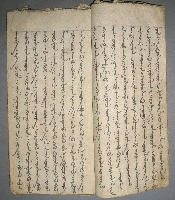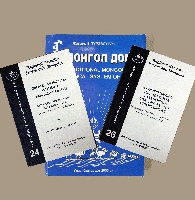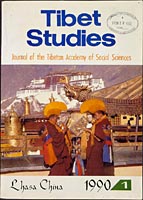INNER ASIA
Mongolian
|

Tale of the Moon Cuckoo (Saran Khokhogan-u Namtar). A manuscript copy of the famous 19th-century
religious opera written and produced by Danzan Ravjaa. First performed in 1833, this popular opera is
an adaptation of a Tibetan didactic work about a noble prince who becomes trapped in the body of a
cuckoo. The nineteen leaves include several marked passages, presumably for use by the actors.
Mongolian Collection, Asian Division.
|
During the early decades of the 20th century, Mongolia's close relationship with the Soviet Union resulted in the widespread use of the Cyrillic alphabet for written Mongolian. Thus, much of the modern material coming into the Library was either in Cyrillic or in the classical vertical script, adopted from the Uighurs is the 13th century. Most of the latter books came from the Library's exchange program with the National Library of China during the 1970s and 1980s. (Mongolian publications in Cyrillic were acquired through Moscow.)
Along with the opening up of the political system in the early 1990s,
Mongolia's publishing industry also began expanding. Through a bibliographic
representative in Ulaanbaatar, the Library's holdings have also increased sharply. New Mongolian publications include works of history, literature, poetry, religion, and art. There have also been an especially large number of publications on Chinggis Khan to coincide with the 2006 celebration of the 800th anniversary of Mongolian statehood.
The outburst of intellectual freedom since the 1990s has resulted in the re-discovery of the works of one of Mongolia's most famous playwrights and artists, Danzan Ravjaa (1803-1856), the "Lord of the Gobi." A Buddhist lama, Danzan Ravjaa founded the Khamaryn Monastery in the east Gobi, where he also built Mongolia's first theater and a secular art school. Although many worshiped him as a saint, Danzan Ravjaa was also an outspoken man who made enemies and died after drinking a poisoned cup of vodka. His writings, art and other possessions were then carefully hidden by his assistant, Balshinchoijoo, and guarded as a sacred trust by Balshinchoijoo's descendents. During a wave of repression by the communist authorities in the 1930s, a portion of the collection was buried in the Gobi, only to be unearthed in 1990 by the current guardian. The Library holds several of Danzan Ravjaa's works, including a manuscript copy of his best-known play, Tale
of the Moon Cuckoo.
|

A selection of modern Mongolian publications. Current acquisitions on Mongolia include publications on economics, development, trade, foreign policy and defense issues. Included
here are two publications of The Institute of Strategic Studies, Ulaanbaatar.
Mongolian Collection, Asian Division.
|
Another contribution to the flowering of Mongolian scholarship and national
pride was the printing of the first translation from Chinese into Mongolian
of the complete Yuan Shi, the history of the Mongol empire from the time
of Chinggis Khan to the fall of the Yuan dynasty in 1368. The Mongolian
scholar Chimediin Demchigdorj (1863-1932), who wrote under the pen name “Dandaa,” completed
the translation of the massive work in 1928 but his manuscript translation
was available only in the National Library of Mongolia until it was recently
published in Ulaanbaatar. The Library now holds a reprint of the Dandaa
translation, which corrects a number of errors made in the original compilation
of the Yuan Shi by Chinese scholars in the first years of the Ming dynasty.
The papers of Owen Lattimore (1900-1989), one of the best-known Western
scholars on Mongolia and Inner Asia, are available in the Manuscript Division
of the Library, with some items to be found in other divisions. Among
the Lattimore papers are records of his field research in Mongolia as
well as Manchuria and Beijing and his transcribed notes of ethnographic,
historical and cultural observations made during his travels. A finding
aid is available.
The Library's holdings on contemporary Mongolia are extensive, making
it an important resource for researchers. Besides recent books, there
are several thousand monographs, 160 serial titles and over 2,000 microfiche.
Eight Mongolian newspapers are also available on microfilm. Publications
on contemporary foreign policy and defense issues, such as the annual
report on regional security issues, published by the Institute for Strategic
Studies in Ulaanbaatar, may be found in the collection.
Electronic Resources: The Law Library’s “Multinational
Collections Database: Mongolia” provides bibliographic information
on Mongolian material in its reference collection.
Tibetan
|

Tibet Studies: A Current Tibetan Periodical.
|
The turbulent history of the Tibet Autonomous Region of the
People's Republic of China since 1950 has complicated the Library's
efforts to build its holdings of modern Tibetan publications.
Fortunately, the Library's New Delhi Field Office was well positioned
to take advantage of the upsurge in Tibetan publishing in India,
Nepal, and Bhutan following the flight of the Dalai Lama to India
in 1959 and the subsequent refugee influx. As a result, the majority
of the Library's books in the Tibetan language are reprint editions
purchased by the New Delhi Field Office since 1962. Of the Library's
approximately 10,000 Tibetan volumes, about 6,500 were purchased
by the New Delhi Field Office.
With normalization of relations between the United States and
China that began in 1972 and with the end of China's Cultural
Revolution in 1976, Tibetan language publications from the People's
Republic of China became increasingly available to the Library.
Exchange agreements with scholarly institutions in China and
four procurement missions to Tibet by Library staff since the
1990s have helped the Library obtain current Tibetan publications,
including new printings of old woodblock texts as well as modern
Tibetan literature. About 1,500 of the Library's Tibetan volumes
are modern publications from the People's Republic of China.
Since 1999, over 1,000 volumes of Tibetan texts printed from
the original woodblocks have been added to the rare book collection,
including over 300 volumes from the famous 18th-century Derge
Printing House. In addition, the Library has about 40 serial
titles, 200 reels of microfilm, and 1,300 microfiche of Tibetan
material.
|

Tibetan Books Starting the
Journey to the Library of Congress, 1926. At the request
of the Library of Congress, Joseph Rock bought complete
sets of the Kanjur and Tanjur, the Tibetan
Buddhist canon, at the monastery of Choni in western Kansu
province (China). Rock had the books packed in ninety-two
boxes and loaded on mules, seen here as they began the
seven-day journey from Choni to the provincial capital
of Langchow. Later trapped in the town of Sian during a
lengthy siege, the books eventually reached Shanghai after
more than a year. They arrived in Washington in 1928 and
are now part of the Asian Division's Tibetan collection. (Rock
Collection, Prints and Photographs Division)
|
The Library's Archive of Folk Culture has an interesting
set of wire recordings made in 1950 in Kalimpong, northeastern
India's "gateway" to
Tibet, by the anthropologist Prince Peter of Greece and Denmark.
The recordings include recitations of traditional Tibetan stories,
such as "The Story of the Rabbit" and part of the epic "History
of King Gesar," as well as esoteric Lamaist ceremonies. When
Prince Peter was making his recordings, Kalimpong was a major
center for Tibetan political activity, intensified by the People's
Liberation Army's ongoing occupation of Tibet. Prince Peter made
an especially timely recording of a November 15, 1950, luncheon
conversation among senior Tibetan officials, Chinese scholars,
Indian and Chinese diplomats, and the sister of the Dalai Lama.
Besides the 2,000 photographs taken by Joseph Rock in western
China, many of which are of Tibetan lamas and monasteries, the
Prints and Photographs Division has a collection of "Scenes of
Tibet" from the 1930-1933 German expedition led by Ernst Schaefer.
The Motion Picture, Broadcasting, and Recorded Sound Division
holds a large collection of recorded Tibetan music and many films
and videos of Tibet. Among the latter is the exhaustive film
record of the German-Tibetan expedition of 1938-1939 that began
in Darjeeling, India, and continued on to Lhasa. The film footage
contains some interesting scenes of a Tibetan New Year's festival
in Lhasa and shots of various Tibetan officials.
Mongolian: With the opening up of the Mongolian political
system in the early 1990s, the Library's New Delhi Field Office
began acquiring a small but increasing number of modern Mongolian
publications.
Electronic Resources: The Tibetan
Buddhist Resource Center in New York is currently digitizing
many of the Tibetan texts held by the library and is releasing
them on external hard drives and CDs. This collection will eventually
contain some 12,000 volumes and will make large Tibetan texts
increasingly accessible.
|